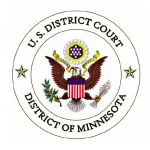UNITED STATES DISTRICT COURT
DISTRICT OF MINNESOTA
| Richland/Wilkin Joint Powers Authority, a Minnesota-North Dakota Joint Powers Authority,
Plaintiff, |
Civil File No. 0:13-cv-02262-RHK-LIB |
| vs. | . | . |
| United States Army Corps of Engineers; John McHugh, Secretary of the US Army Corps of Engineers (in his official capacity); Jo-Ellen Darcy, Assistant Secretary of the Army for Civil Works (in her official capacity); and Col. Dan Koprowski, District Commander, St. Paul District, US Army Corps of Engineers (in his official capacity),
Defendants. |
MINNESOTA DEPARTMENT OF NATURAL RESOURCES’ MEMORANDUM OF LAW IN SUPPORT OF ITS MOTION FOR LEAVE TO PARTICIPATE AS AN AMICUS CURIAE |
| and | . | . |
| Fargo-Moorhead Flood Diversion Board of Authority, | . | . |
| Defendant-Intervenor. | |
| . | . |
INTRODUCTION
Pursuant to Federal Rules of Civil Procedure 5 and 7, the Minnesota Department of Natural Resources (“MDNR”) files this Memorandum in support of its motion for leave to participate as an amicus curiae in this matter. MDNR has a significant interest in this matter because the Fargo-Moorhead Flood Diversion Board of Authority (“Diversion Authority”) asserts that the proposed Fargo-Moorhead flood diversion project (“Project”) is not subject to State regulation. The Project would flood tens of thousands of acres of Minnesota farmland in order to expand development opportunities in the Fargo-Moorhead metropolitan area. The Project also would require construction of a high-hazard dam on the Red River, upstream of Minnesota communities. This high-hazard dam requires MDNR dam-safety and work-in-public-waters permits, and triggers a mandatory Environmental Impact Statement (EIS) under Minnesota law. MDNR’s participation as an amicus curiae can assist the Court in understanding MDNR’s regulatory authority over the proposed high-hazard dam on the Red River.
ARGUMENT
I. STANDARD FOR AMICUS PARTICIPATION.
The federal district courts have broad discretion to permit participation by an amicus curiae where the appearance will be helpful to the court. Mausolf v. Babbit, 158 F.R.D. 143, 148 (D. Minn. 1984), rev’d on other grounds, 85 F.3d 1295 (8th Cir. 1996). Though there is no Federal Rule of Civil Procedure governing participation by an amicus curiae or other formal prerequisites for qualifying as an amicus, courts will often invite the participation of an amicus who will offer information that is both timely and useful. Leigh v. Engle, 535 F.Supp. 418, 420 (N.D. Ill. 1982). The court’s decision on amicus status is unique to the circumstances of the particular case before it and is guided by whether such participation “will assist the judge by presenting ideas, arguments, theories, insights, facts, or data that are not to be found in the parties’ briefs.” Voices for Choices v. Ill. Bell Tel. Co., 339 F.3d 542, 545 (7th Cir. 2003). The federal district courts of Minnesota have readily granted requests for amicus status on a variety of bases. For example, in Johnson v. Hubbard Broadcasting, Inc., 940 F.Supp. 1447, 1451 (D. Minn. 1996), the court allowed the Equal Employment Opportunity Commission (“EEOC”) to participate as an amicus in an employment dispute to advise the court of, among other things, the possible implications of the interpretation of an employment contract on federal policy.1 In Mille Lacs Band of Chippewa Indians v. State of Minnesota, 140 F.R.D. 390, 394 (D. Minn. 1992), in denying petitions brought by Minnesota counties to intervene in an action brought by the Mille Lacs Band of Chippewa Indians against the State to enforce alleged treaty rights, the court invited the same counties to petition for amicus status if they believed “supplemental legal discussion would assist the court.”2 In Ossman v. Diana Corp., 825 F.Supp. 870, 873, n.13 (D. Minn. 1993), the court allowed the North American Securities Administrators Association to file an amicus memorandum in a shareholders’ action against a number of corporations and corporate officers “[i]n the interest of compiling a comprehensive record on … difficult issues before [the court].”
II. MDNR’S PARTICIPATION AS AN AMICUS WILL ASSIST THE COURT IN UNDERSTANDING THE STATE OF MINNESOTA’S INTEREST IN REGULATING THE RED RIVER.
MDNR can assist the Court in understanding the potential impact of this Project on the State of Minnesota and the State’s role in regulating aspects of the Project that impact
1 The EEOC argued that enforcing an arbitration clause, rather than allowing the plaintiff to pursue a discrimination claim in court, would “run counter to federal policy.” 940 F.Supp. at 1451.
2 The Eighth Circuit ultimately reversed the district court’s denial of intervention but did not alter the lower court’s statement on amicus status. Mille Lacs Band of Chippewa Indians v. State of Minn., 989 F.2d 994 (8th Cir. 1993).
Minnesota public waters, such as the high-hazard dam on the Red River. The Project would have a major impact in Minnesota by flooding Minnesota farmland and placing a high-hazard dam upstream of Minnesota residents. MDNR regulates public waters, including the Red River, and is responsible for evaluating applications for work-inpublic-waters and dam-safety permits for the proposed high-hazard dam on the Red River. Minn. R. 6115.0150-.0520 (2013) (regulations governing work in public waters and dam safety permits).
In its motion for an injunction to stop Plaintiff Richland/Wilkin Joint Powers Authority (“JPA”) from proceeding with its action in Minnesota District Court in Wilkin County, the Diversion Authority asserts that MDNR’s regulation of the Red River is preempted to the extent that it conflicts with the Project. (Diversion Authority’s Supplemental Mem. Regarding Anti-Suit Inj. at 13.) The Diversion Authority seems to suggest that the MDNR may exercise its authority to grant a permit for the Red River dam, but that any decision to deny a permit would conflict with federal law. (Id.) MDNR would be harmed by a Court order concluding that State regulation of the Project is partially or wholly preempted because MDNR’s environmental review of the Project is continuing and MDNR has not yet begun the process of evaluating whether permits may be issued for the Project.3
Though the Diversion Authority states that this Court may not need to address the issue of preemption in resolving the pending motion, the issue of preemption may also be
3 The proposed dam triggered mandatory environmental review under Minnesota law, and according to Minnesota law, MDNR is the governmental unit responsible for conducting that review. Minn. R. 4410.4400, subp. 18, .0500, subp. 1 (2013). The Corps has recognized that the MDNR EIS will address issues relating to the proposed dam that are not adequately covered in the FR/EIS. (Declaration of Randall Doneen ¶ 25.) CASE 0:13-cv-02262-JRT-LIB Document 78 Filed 07/22/14 Page 4 of 5
relevant to the merits of this matter. (Id.) JPA asserts in this action that the Corps has violated the National Environmental Policy Act (“NEPA”) by failing to fully address Minnesota law issues, such as DNR permitting requirements, in the FR/EIS. (2nd Am. Compl. at 25-31.) The Diversion Authority may argue in response that the Project is not subject to State regulation. Thus, even if the Court does not ultimately address the issues of sovereign immunity or preemption in response to the pending motion, the Court may need to address the question of whether MDNR has permitting authority over the Project when it decides the merits of the case. In either case, MDNR’s participation as an amicus curiae may be helpful to the Court in deciding this issue.
CONCLUSION
For the above reasons, MDNR respectfully requests that the Court grant its request for leave to participate in this matter as an amicus curiae.
Dated: July 22, 2014
Respectfully submitted,
OFFICE OF THE ATTORNEY GENERAL
State of Minnesota
NATHAN J. HARTSHORN
Assistant Attorney General
Atty. Reg. No. 0320602
445 Minnesota Street, Suite 1800
St. Paul, Minnesota 55101-2134
(651) 757-1252 (Voice)
ATTORNEY FOR MINNESOTA
DEPARTMENT OF NATURAL RESOURCES
CASE 0:13-cv-02262-JRT-LIB Document 78 Filed 07/22/14
UNITED STATES DISTRICT COURT
DISTRICT OF MINNESOTA
| Richland/Wilkin Joint Powers Authority, a Minnesota-North Dakota Joint Powers Authority,
Plaintiff, |
Civil File No. 0:13-cv-02262-RHK-LIB |
| vs. | . | . |
| United States Army Corps of Engineers; John McHugh, Secretary of the US Army Corps of Engineers (in his official capacity); Jo-Ellen Darcy, Assistant Secretary of the Army for Civil Works (in her official capacity); and Col. Dan Koprowski, District Commander, St. Paul District, US Army Corps of Engineers (in his official capacity),
Defendants. |
LR 7.1(F) WORD COUNT COMPLIANCE CERTIFICATE REGARDING MINNESOTA DEPARTMENT OF NATURAL RESOURCES’ MEMORANDUM OF LAW IN SUPPORT OF ITS MOTION FOR LEAVE TO PARTICIPATE AS AN AMICUS CURIAE |
| and | . | . |
| Fargo-Moorhead Flood Diversion Board of Authority, | . | . |
| Defendant-Intervenor. | |
| . | . |
I, Nathan J. Hartshorn, certify that Defendant Minnesota Department of Natural Resources’ Memorandum of Law In Support Of Its Motion for Leave to Participate as an Amicus Curiae complies with Local Rule 7.1(f).
I further certify that, in preparation of this document, I used Microsoft Word Version 2010, and that this word processing program has been applied specifically to include all text, including headings, footnotes, and quotations in the following word count.
I further certify that the above referenced memorandum contains 1,242 words.
Dated: July 22, 2014
OFFICE OF THE ATTORNEY GENERAL
State of Minnesota
NATHAN J. HARTSHORN
Assistant Attorney General
Atty. Reg. No. 0320602
445 Minnesota Street, Suite 1800
St. Paul, Minnesota 55101-2134
(651) 757-1252 (Voice)
(651) 282-2525 (TTY)
ATTORNEY FOR MINNESOTA
DEPARTMENT OF NATURAL RESOURCES
CASE 0:13-cv-02262-JRT-LIB Document 78-1 Filed 07/22/14
Views: 184

